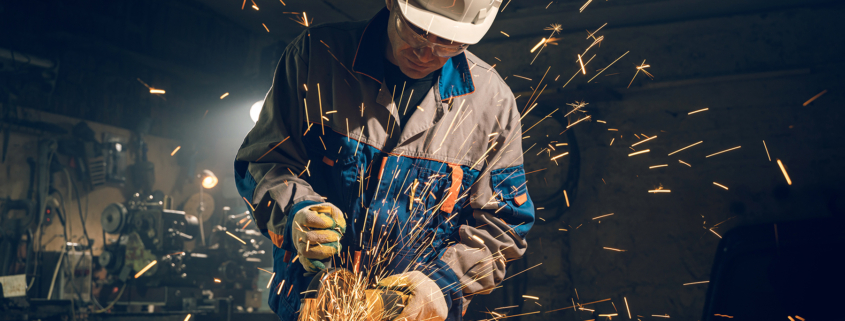Prevent Hazards and Potential Losses Caused By Hot Work
Losses caused by hot work are among the leading reasons mid-size commercial or industrial properties make insurance claims.
One of the leading causes of fire in Canada, and one of the top three reasons for mid-size commercial or industrial property losses is from hot work operations. Hot work is any occupation that involves working with ignition sources near flammable materials – soldering, welding, grinding, and cutting, for example. If these activities are conducted near combustible dust or flammable gases, liquids, or materials, there’s an increased risk of fire or even explosion.
Hot work accounts for considerable property losses each year. However, safety procedures implemented effectively and a permit system for hot work can help to significantly reduce these fire hazards.
Significant damage and losses… from only one small spark
It’s not unusual for commercial and light manufacturing operations to have a designated area specifically used for frequent hot work.
It only takes a very small spark to have a devastating impact. The destruction of property and equipment, the interruption of business and even the loss of jobs for employees. Worse yet, it has the potential to put lives at risk. And, in the aftermath, as a business recovers, they can lose valued customers to the competition. The losses caused by hot work can seem endlessly ongoing.
One little welding spark amidst the wrong conditions can cause overwhelming damage and destruction.
Losses caused by hot work – mitigate the risks
You may not consider this, but it’s possible for a loose spark to sit in a pile of dust and smoulder, only to come to life in the middle of the night. With no one around to stop it, the potential damage could be devastating.
To mitigate the risks associated with hot work, best practices for hot work are as follows:
- Ensure all equipment functions properly before any work begins.
- Ensure that fire extinguishers are in working order, are readily available and easy to access.
- Utilize all appropriate personal protective devices. They should always be available onsite. Train each worker on their use. They should also be cleaned and stored appropriately.
- Thoroughly inspect the work area before work begins. Check for combustible and flammable surfaces nearby (walls, ceilings, partitions, etc.). Cover them with a fire resistant and heat insulating material to prevent accumulation of heat and possible ignition.
Look for combustibles in and around the hot work zone
- As much as possible, move all combustibles away from the hot work area.
- If combustibles can’t be cleared away, you can cover them with fire resistant shields or blankets. Be sure to protect any exposed or nearby equipment and gas lines from flying or stray sparks or hot items.
- Tidy any combustible and flammable materials on the floors of the work zone and surrounding area. If the floors are at risk of combusting, keep them wet or cover them with damp sand or fire resistant blankets. NOTE: Only use water if you know electrical circuits have been de-energized to prevent electrical shock.
- Remove and clean up spilled oil, grease, or other combustible liquid.
- To prevent ignition, vacuum any debris that is flammable or combustible from duct openings, inside the ventilation or other ductwork. If there are cracks in ducts, seal them. Ensure sparks cannot enter the ducting. Use fire resistant barrier to cover any duct openings.
- Keep first-aid kits well stocked and easy to find and access.
- Find out more best practices CLICK HERE.
Conduct a regular fire watch
Once you have a properly prepared hot work area, it’s also important to conduct a fire watch following any welding, soldering, grinding, or any other work that produces sparks and heat.
Someone should ensure that there is no hidden spark or fire that will smoulder or ignite in the hours after the hot work is complete. Skip or miss the inspection afterwards and risk potentially catastrophic consequences. It may mean paying a employee trained in the proper use of fire suppression equipment to stay longer to keep an eye on the area. It’s an expense that is well worth it, as many victims of hot work disasters will confirm.
There is an alternative, if you don’t have the budget or trained staff to keep fire watch. As best you can, limit hot work to early in the day. There will be time for any stray sparks or smoulders can be caught during the workday. The recommendation is from approximately one to four hours after the completion of hot work to monitor the area.
Permits for hot work
Reducing the hazards is possible through a specific hot work permit system. A two-part tag system, the hot work permit requires that a welder complete a safety checklist before they perform hot work beyond designated hot work areas. Affix one portion of the two-part tag near the work area until completion of the fire watch. The other portion will be on file, audited by management.
The permit system ensures the individual performing the hot work follows the appropriate safety protocols. It requires they sign off on a checklist before working and after the fire watch is complete. A hot work permit is available for purchase from most retailers of safety supplies.
Fire safety program specific to hot work
In any overall industrial or commercial safety program, the hot work safety policy should include hot work permits. It should be a policy that incorporates all hot work activities, on-site, whether performed by staff or third-party contractors.
The hot work component of a safety policy shouldn’t be complicated. It does not. It’s simply a page or two that outlines the specific safety procedures required to conduct hot work.
Questions about your hot work environment and your commercial insurance? Talk to us!



